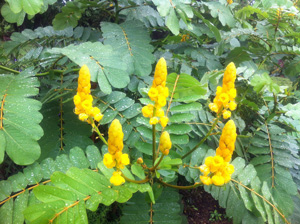Resource Library
Plant of the Week: Candlestick Plant
The University of Arkansas System Division of Agriculture does not promote, support or recommend plants featured in "Plant of the Week." Please consult your local Extension office for plants suitable for your region.
Plant of the Week
Candlestick Plant
Latin: Senna alata

The nursery industry has a passion for short, compact plants. For a grower, it is a smart economic move because more plants can be grown in less space, small plants are easier to handle and they are more efficient to ship. However, these small plants even when well grown just look, well – like runts. I like big and bold, things like the candlestick plant (Senna alata or alternately Cassia alata).
Candlestick plant goes by many common names such as Christmas candle, ringworm shrub or candle bush. It is a member of the legume family and probably originated in Central America but has been so long grown as an ornamental that its exact origins are uncertain. It is a fast growing tropical shrub or small tree capable of reaching 25 feet in height in a frost-free climate, but typically is seen as a 10- to 15-foot tall rounded shrub in gardens.
It has large compound leaves up to 16 inches long with oval, 3-inch long leaflets arranged neatly down the rachis. At night, the leaves fold up. Yellow, erect flower clusters appear at the ends of branches in an open cluster, frequently in groups of five to seven. Blooms begin appearing as soon as the plant makes some growth and continue until night temperatures begin cooling off. Individual flowers open from the base of the truss and are about the size and shape of popcorn while the buds above are still in tight form, giving the inflorescence the general appearance of a lighted candle.
Candlestick plant is as well known by its original Linnaean name of Cassia alata as its more recent name, “Senna.” It has long been cultivated throughout the world and is now considered a weed in many tropical climates -- though it is not banned in any of our more southerly states. It is hardy in zones 10 and 11 (though it often freezes to the ground in even these areas) and may reseed in areas with a long growing season, though I have never seen it do so in the zone 6 gardens I have tended.
Legumes in the Senna genus are a major food source for the caterpillars of the yellow sulfur butterflies. But candlestick plant has developed a defense mechanism against the grazing attack of the caterpillars by enlisting the assistance of ants. Usually nectary glands are located in flowers to attract pollinators, but candlestick plant has nectary glands near the base of the leaves to attract ant armies. While the ants love the sweet honey water, they also need some protein so they sweep the leaves clean of any butterfly eggs as soon as they are laid.
Candlestick plant is a tough, drought-tolerant plant that grows best in any well-drained sunny site. It has a bold, clean look and makes a good plant for massing or for use as tall background plant in the flower border. They give a tropical look to a landscape especially when combined with other lush looking tropical plants such as castor bean and banana plants. If used in a container, make sure it is a big one. Candlestick plant needs it hot so do not plant them until the soil has warmed to at least 65 degrees Fahrenheit. Propagation is easy by seed started in a warm, sunny location.
By: Gerald Klingaman, retired
Retired Extension Horticulturist - Ornamentals
Extension News - September 14, 2012
The University of Arkansas System Division of Agriculture does not maintain lists of retail outlets where these plants can be purchased. Please check your local nursery or other retail outlets to ask about the availability of these plants for your growing area.